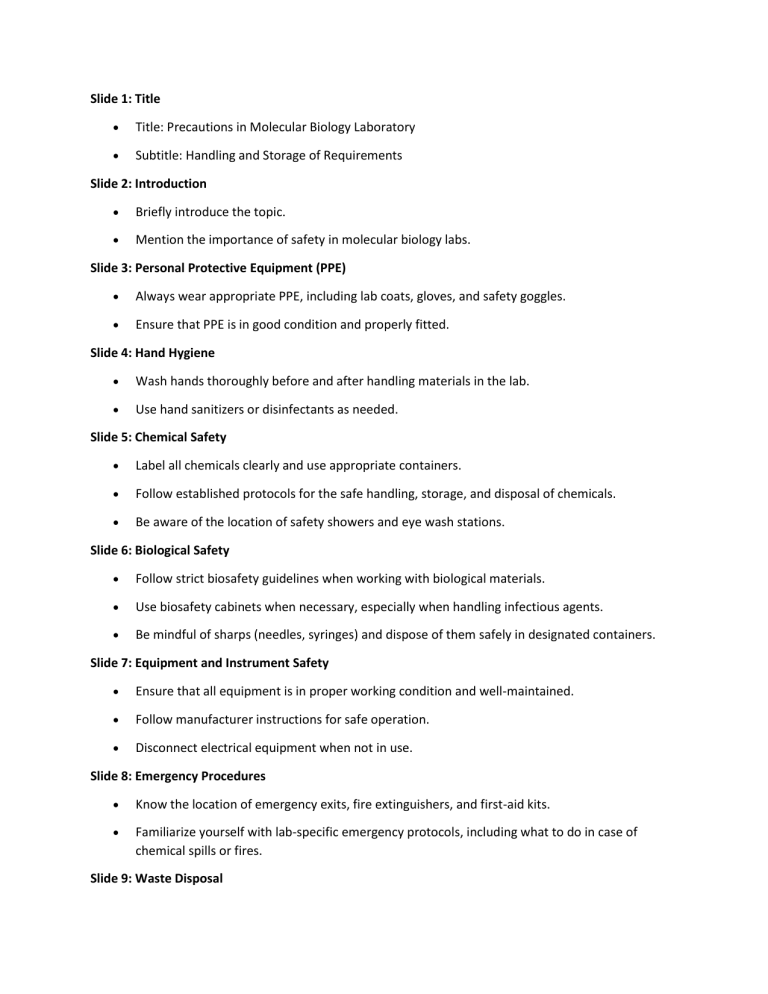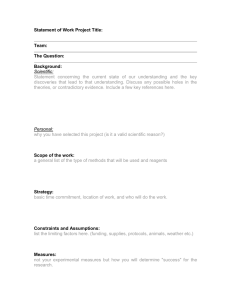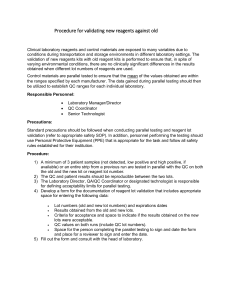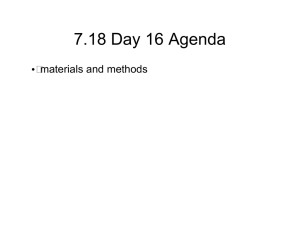
Slide 1: Title Title: Precautions in Molecular Biology Laboratory Subtitle: Handling and Storage of Requirements Slide 2: Introduction Briefly introduce the topic. Mention the importance of safety in molecular biology labs. Slide 3: Personal Protective Equipment (PPE) Always wear appropriate PPE, including lab coats, gloves, and safety goggles. Ensure that PPE is in good condition and properly fitted. Slide 4: Hand Hygiene Wash hands thoroughly before and after handling materials in the lab. Use hand sanitizers or disinfectants as needed. Slide 5: Chemical Safety Label all chemicals clearly and use appropriate containers. Follow established protocols for the safe handling, storage, and disposal of chemicals. Be aware of the location of safety showers and eye wash stations. Slide 6: Biological Safety Follow strict biosafety guidelines when working with biological materials. Use biosafety cabinets when necessary, especially when handling infectious agents. Be mindful of sharps (needles, syringes) and dispose of them safely in designated containers. Slide 7: Equipment and Instrument Safety Ensure that all equipment is in proper working condition and well-maintained. Follow manufacturer instructions for safe operation. Disconnect electrical equipment when not in use. Slide 8: Emergency Procedures Know the location of emergency exits, fire extinguishers, and first-aid kits. Familiarize yourself with lab-specific emergency protocols, including what to do in case of chemical spills or fires. Slide 9: Waste Disposal Segregate waste properly, separating biohazardous, chemical, and general waste. Follow the laboratory's waste disposal procedures and guidelines. Slide 10: Sample Storage Properly label and store samples in designated areas. Use the appropriate storage conditions, such as freezers, refrigerators, or liquid nitrogen tanks. Monitor and record storage temperatures. Slide 11: Data Management Maintain accurate and organized records of your experiments. Backup electronic data regularly to prevent data loss. Slide 12: Training and Education Ensure all personnel are properly trained for their tasks. Keep up-to-date with safety protocols and best practices. Conduct regular safety training sessions for lab members. Slide 13: Compliance with Regulations Stay informed about relevant safety regulations and guidelines from organizations like OSHA, CDC, and NIH. Comply with institutional and laboratory-specific safety policies. Slide 14: Good Laboratory Practices Follow established laboratory protocols and standard operating procedures (SOPs). Minimize clutter in the workspace to reduce the risk of accidents. Feel free to copy and paste this content into your PowerPoint slides, and customize the design and formatting to your preference. Title: Precautions in Handling and Storage of Reagents in Molecular Biology Laboratory Subtitle: Ensuring Accuracy, Safety, and Integrity Presenter's Name Date Slide 2: Introduction Brief introduction to the significance of molecular biology research. The critical role of reagents in research. Objectives of the presentation. Slide 3: Types of Reagents Categorizing reagents used in molecular biology. Importance of understanding the nature of different reagents. References: (List relevant research papers, textbooks, or guidelines.) Slide 4: Reagent Handling Precautions Proper labeling of reagents. Importance of Personal Protective Equipment (PPE). Safe pipetting techniques. Preventing contamination during handling. Correct procedures for safe disposal. References: (Cite authoritative sources or laboratory protocols.) Slide 5: Reagent Storage Precautions The significance of proper storage conditions. Handling temperature-sensitive reagents. Safe storage of hazardous chemicals. Monitoring shelf life and expiration dates. Best practices in inventory management. References: (Cite relevant laboratory manuals or guidelines.) Slide 6: Biological Reagents Handling and storage of live cells and cultures. Managing DNA, RNA, and protein samples. Ensuring sterility and preventing contamination. References: (Cite scientific papers or laboratory safety documents.) Slide 7: Chemical Reagents Safely managing hazardous chemicals. The role of Material Safety Data Sheets (MSDS). Proper storage and segregation practices. References: (Cite safety regulations or chemical safety guides.) Slide 8: Temperature-sensitive Reagents Identifying temperature-sensitive reagents. Guidelines for proper storage conditions. Avoiding the impact of freeze-thaw cycles. References: (Cite manufacturer instructions or research publications.) Slide 9: Shelf Life and Expiration Dates Importance of regularly monitoring reagent expiration. Procedures for safely discarding expired reagents. References: (Cite relevant laboratory protocols or safety standards.) Slide 10: Inventory Management Effective organization of reagent inventory. Implementing reorder alerts and tracking quantities. The FIFO (First In, First Out) principle for inventory control. References: (Cite inventory management best practices or laboratory guidelines.) Slide 11: Laboratory Safety Emergency procedures and response protocols. Proper spill response and containment. Ensuring fire safety in the laboratory. References: (Cite relevant safety regulations, fire safety guidelines, or laboratory safety manuals.) Slide 12: Real-Life Examples Case studies and examples illustrating the consequences of improper reagent handling and storage. References: (Cite specific case studies, if available.) Slide 13: Regulatory Compliance Overview of relevant safety regulations and guidelines applicable to molecular biology laboratories. References: (Cite the specific regulations or guidelines in your jurisdiction.) Slide 14: Conclusion Summary of key takeaways from the presentation. Reinforce the importance of safety, accuracy, and integrity in molecular biology research. Slide 15: Questions and Discussion Open the floor for questions, discussions, and clarifications. Slide 16: Thank You Express gratitude to the audience for their attention and participation. Remember to include complete citations for your references in a separate section of your presentation, or in a handout if necessary


